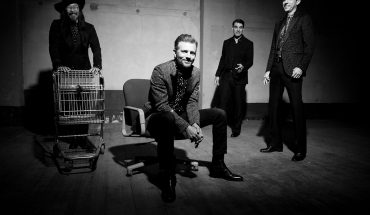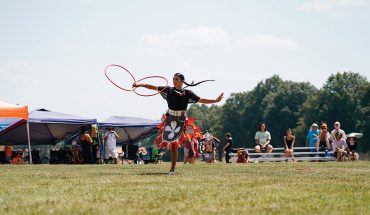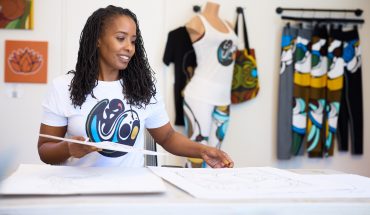
Kiki Farish in her studio at Artspace. She is known for her pencil drawings, which often incorporate words.
by Ann Brooke Raynal
photographs by Jillian Clark
“Pointed sharp things frighten us,” says Raleigh artist Kiki Farish. “Rounded things feel safer. When we see curve in design or drawing, we are not scared of it.”
Farish is speaking to a group of 15 teenage artists in the North Carolina Museum of Art’s teen program, which she serves as artist in residence. A professor at Meredith College, Farish understands the drive, fears, and preoccupations of young artists.
The students sit at tables with mirrors, drawing self-portraits. Farish takes pains to explain that “all artwork is self-portrait.”
She asks the kids to brainstorm a list of character traits, positive and negative, and how an artist might translate those traits. They discuss how character and strong emotion can be communicated through shadows, dark patches, and hard lines. Farish folds herself into a tight ball, arms wrapped around her knees. “Does ‘optimistic’ look like this?” The students shake their heads. She expands her body in all directions, head thrown back. Yes, they nod. “So, what does that look like on paper?”
Farish makes art of her own in a shared studio at downtown’s Artspace. A recipient of the 2014-2015 N.C. Arts Council Visual Art Fellowship, Farish is known mainly for her pencil drawings, but the fellowship and a recent award from the United Arts Council of Raleigh and Wake County encouraged Farish to experiment with oil portraits. Most recently, her work was included in Line, Touch, Trace, a group exhibition at the NCMA.
Traces remain
Clayboard, a clay-coated hardboard panel, is Farish’s favorite surface. It holds graphite without smudging, but also allows for blending and erasure, shallow or deep. She prefers an electric eraser for the surface, similar to one her father discovered for her when she was a teenager herself. Unless the clayboard is erased completely, she says, the old lines and traces remain, so a work retains its history. “I like the way you can erase back to the surface. But most of the time, you want to keep that history,” Farish says.
The students study Farish’s two paintings on display. Hospice is the first work she completed after her father’s death. The words “green,” “touch,” “take,” and “need” float and recede amid shadows, flowers, and brambles, capturing both the experience of hospice and her father’s loss of speech. “Facial expressions were so important to him at the end,” Farish says. “He had left the words behind.”
The canvas Move also incorporates written words, sometimes too faint to read. “It’s fun and challenging to work text into a piece,” she says. “It adds another layer of complexity.”
Subtlety is what she’s after. “As an artist you can manipulate only so far. Ultimately, the viewer brings his or her own experience into it. It’s fun to see how other people respond. The main thing is that they respond, that they are engaged.”
The students seem to understand Farish’s work instinctively. They point out dissolving lines. Trace marks and scratches in the clayboard seem to indicate movement, both physical and psychological. A student ventures: “It’s hard to know where something starts and stops. Some lines continue off the board. Some parts are moving forward, some backward.”
Farish agrees. “Yes, there’s ambiguity. When capturing human relationships, there’s always a sense of ambiguity. There are no hard edges or boundaries in my relationships with people.” Another student comments on the hard lines and dark patches in the work. Farish nods: “This one is fairly screaming anxiety.”
As they begin their self-portraits, Farish asks the students to begin with a blind contour exercise, drawing themselves while looking in the mirror, not at the image they are creating. Farish demonstrates a blind contour drawing herself at the excruciatingly slow pace she asks her class to maintain. This practice teaches hand-eye coordination, and forces the artist to spend more time with a subject. “This looks nothing like me,” she laughs, holding up her contour drawing. “But know I know myself better now.”
After an almost mathematical lesson on facial proportions, students begin working on their self-portraits. Many try to get ahead of Farish’s instructions, attempting to perfect their portraits. But a finished product is not what Farish is after.
Some groan when she instructs the whole class to erase 50 percent of their work. Farish urges her students to be process- rather than product-oriented. She sees emphasis on “product” as a damper to creativity and risk-taking. “There is risk in creating art,” she says. “Risk provokes anxiety. There’s tension in that contrast between wanting to be invisible and wanting to be visible.”
Finally, Farish asks students to choose one of the personality traits from the list they generated earlier to bring out in their portrait. “We are using ourselves as sources, not picture-perfect images of us. Pay attention to how your marks will represent this.”
Suddenly, the “ice-breaker” exercise, the close examination of Farish’s own work, and the self-portrait work come together as the students work to express something more than their mirror image through the placement, depth, intensity, pattern, and layers of their markings.
Farish finds teaching to be good discipline. “Color theory, for example, can be very technical,” she says. “You really have to know your stuff to turn around and teach it.” And though young artists will always glamorize art as mostly inspiration, Farish wants to highlight the importance of practice and persistence. “Art is a skill. Students can always work on skills.”
Over the course of a workshop or a semester, Farish says, she wants her students “to leave with confidence, to present ideas without apologizing for them. That’s what I love about art: it teaches critical thinking and problem solving.”
The next ArtScene teen event,“Work in Progress” with Kiki Farish is scheduled for Saturday April 25 from 1-5 p.m. For more information or to register, visit ncartmuseum.org.




